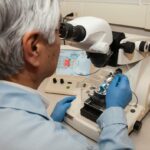The theory of evolution, proposed by Charles Darwin in the 19th century, remains one of the most influential scientific theories. It postulates that all species of organisms arise and develop through the natural selection of small, inherited variations that increase the individual’s ability to compete, survive, and reproduce. Understanding evolution is not just about acknowledging our past but also about appreciating the intricate web of life that sustains our planet.
The Role of Genetics in Supporting Darwin’s Theory
Understanding the Basics of Genetics
Genetics, the study of genes, genetic variation, and heredity in living organisms, plays a crucial role in supporting Darwin’s theory. Genes carry the information that determines traits, which are features or characteristics that are passed on to you — or inherited — from your parents. Through the process of mutation and natural selection, these traits can change over time, leading to evolution.
DNA Similarities Among Different Species
One of the most compelling pieces of evidence for evolution is the striking similarity of the DNA of different species. Humans share about 98.7% of our DNA with chimpanzees, about 85% with mice, and even about 50% with bananas. This suggests that we all descended from a common ancestor.
Evolutionary Changes Observed in Genetic Structures
Genetic structures can also provide evidence for evolution. For instance, scientists have observed that some species have genes that are “turned off” or are non-functional but are functional in other species. This suggests that these species share a common ancestor where these genes were functional.
Insights from Paleontology
The Study of Fossils and Its Relevance to Evolution
Paleontology, the scientific study of the history of life on Earth through the examination of plant and animal fossils, provides some of the most direct evidence of evolution. Fossils provide a record of the history of life, with the oldest fossils dating back to about 3.5 billion years ago.
Fossil Records Supporting the Theory of Evolution
The fossil record supports the idea of evolution by showing us the progressive changes that have occurred in species over millions of years. For example, the evolution of the horse is well-documented in the fossil record, with clear evidence of gradual changes in size and anatomy over time.
Case Studies of Evolution Observed in Paleontological Findings
One of the most famous case studies in paleontology is the evolution of birds from theropod dinosaurs, which is supported by numerous fossil findings. The Archaeopteryx, a fossil discovered in the late 19th century, has characteristics of both birds and dinosaurs, making it a key piece of evidence for this evolutionary link.
Geological Evidence for Evolution
The Science of Geology and Its Connection to Evolution
Geology, the study of the solid Earth and the processes by which it is shaped and changed, provides important context for understanding evolution. The geological timescale, which divides Earth’s history into eras, periods, and epochs, provides a framework for understanding the sequence of evolutionary events.
Geological Timelines and the Evolution of Species
The geological timeline offers evidence for evolution by showing when different kinds of organisms appeared and disappeared in the fossil record. For example, the first multicellular organisms appear in the fossil record about 600 million years ago, while the first mammals appear about 200 million years ago.
Geological Strata and Fossil Distribution
The distribution of fossils in different geological strata also supports the theory of evolution. Older strata contain fossils of simpler organisms, while younger strata contain fossils of more complex organisms. This pattern is consistent with the idea that life has evolved from simple to complex forms.
Evidence from Comparative Anatomy
Understanding Comparative Anatomy
Comparative anatomy, the study of similarities and differences in the anatomy of different species, provides further evidence for evolution. It reveals functional and evolutionary relationships between different organisms.
Homologous Structures and Their Evolutionary Implications
Homologous structures, or organs that are similar in different species because they were inherited from a common ancestor, provide evidence for evolution. For example, the forelimbs of humans, cats, whales, and bats are homologous structures. They have different functions but similar bone structures, indicating a common evolutionary origin.
Vestigial Organs as Evidence of Evolution
Vestigial organs, or structures that have no apparent function in one species but are functional in others, also support the theory of evolution. For example, humans have a vestigial structure called the appendix, which is thought to have been used for digesting leaves in our distant ancestors.
The Role of Embryology in Understanding Evolution
Overview of Embryology and Its Significance in Evolution
Embryology, the study of the development of an embryo from the fertilization of the ovum to the fetus stage, offers another perspective on evolution. The embryos of many different kinds of animals: birds, reptiles, mammals, etc., look very similar and it is often difficult to tell them apart.
Similarities in Early Developmental Stages Among Different Species
Many animals, from chickens to humans, show similar embryonic development stages, suggesting a common ancestry. This is because all animals carry with them the genetic information of their ancestors, even if these ancestral traits appear only briefly during their embryonic development.
Evolutionary Interpretations of Embryological Findings
The similarities in embryonic development among different species have led scientists to conclude that these species share a common ancestry. This supports the theory of evolution, which predicts that related organisms will share common developmental stages.
Molecular Biology and Evolution
Introduction to Molecular Biology
Molecular biology, the study of the molecular underpinnings of the processes of replication, transcription, translation, and cell function, provides yet another layer of evidence for evolution. It allows scientists to study the physical and chemical properties of molecules in a cell and how they interact.
Molecular Similarities and Differences Among Species
Molecular biology has revealed that all organisms share the same basic molecular machinery, including DNA, RNA, and proteins. These similarities suggest a common origin of all life. At the same time, the differences in these molecules between species can be used to reconstruct their evolutionary history.
Molecular Clocks and Their Role in Tracking Evolutionary Changes
Molecular clocks, which use the rate at which certain genetic mutations accumulate over time, can help track evolutionary changes. By comparing the DNA sequences of different species, scientists can estimate how long ago their common ancestor lived.
Biogeography: The Geographic Distribution of Species
Understanding Biogeography
Biogeography, the study of the distribution of species and ecosystems in geographic space and through geological time, provides more evidence for evolution. Different regions of the world have distinct plants and animals.
Geographic Distribution of Species as Evidence of Evolution
The geographic distribution of species, or where species are located, also supports the theory of evolution. For example, Australia is home to more than 1,000 species of spiders, many of which are found nowhere else. This unique distribution of wildlife suggests that these species have evolved in relative isolation, due to Australia’s separation from the other continents.
Case Studies of Biogeographical Evidence Supporting Evolution
One of the most famous examples of biogeographical evidence for evolution is Darwin’s study of finches on the Galapagos Islands. The finches on each island had different types of beaks, which Darwin concluded were adaptations to the different types of food available on each island.
The Role of Observational Science in Evolution
The Importance of Observational Science in Understanding Evolution
Observational science, which involves observing the natural world and its phenomena, plays a key role in understanding evolution. It allows scientists to gather data and draw conclusions based on what they observe.
Examples of Observed Evolutionary Changes in Nature
There are many examples of observed evolutionary changes in nature. For instance, the peppered moth in England during the industrial revolution changed from mostly white to mostly black due to pollution. This is a clear example of natural selection, where the black moths were better able to survive and reproduce in the polluted environment.
Evolutionary Theory in Modern Science
The Ongoing Relevance of Darwin’s Theory in Contemporary Science
Despite being over 150 years old, Darwin’s theory of evolution continues to be the foundation of modern biology. It provides a framework that unifies all biological sciences under one theoretical umbrella, explaining both the unity and diversity of life.
Modern Scientific Discoveries Supporting Evolution
Modern scientific discoveries continue to support the theory of evolution. For example, the discovery of DNA and the understanding of genetic inheritance have provided a molecular mechanism for Darwin’s theory. Additionally, the study of antibiotic resistance in bacteria provides a contemporary example of evolution in action.
Key Takeaways
Key Takeaways, various scientific disciplines, from genetics to paleontology to molecular biology, provide robust support for Darwin’s theory of evolution. This theory has not only stood the test of time but continues to be refined and expanded upon with new scientific discoveries. It remains one of the most profound and influential ideas in science, shaping our understanding of the natural world and our place within it.
Frequently Asked Questions
What is Darwin’s theory of evolution?
Darwin’s theory of evolution is a scientific theory that all species of organisms arise and develop through the natural selection of small, inherited variations that increase the individual’s ability to compete, survive, and reproduce.
How does genetics support the theory of evolution?
Genetics supports the theory of evolution by showing how traits can change over time through mutation and natural selection. The DNA similarities among different species also suggest a common ancestor, supporting the idea of evolution.
What role does paleontology play in understanding evolution?
Paleontology provides some of the most direct evidence of evolution. The fossil record shows the progressive changes that have occurred in species over millions of years, supporting the idea of evolution.
How does comparative anatomy provide evidence for evolution?
Comparative anatomy provides evidence for evolution through the study of homologous structures, or organs that are similar in different species because they were inherited from a common ancestor. Vestigial organs, or structures that have no apparent function in one species but are functional in others, also support the theory of evolution.
What is the significance of embryology in understanding evolution?
Embryology offers another perspective on evolution. The similarities in embryonic development among different species suggest a common ancestry, supporting the theory of evolution.
How does biogeography support the theory of evolution?
Biogeography supports the theory of evolution by studying the distribution of species and ecosystems in geographic space and through geological time. The unique distribution of wildlife in different regions suggests that these species have evolved in relative isolation.
References
- Darwin, C. (1859). On the Origin of Species. John Murray.
- Futuyma, D. J. (2013). Evolution. Sinauer Associates.
- Ridley, M. (2004). Evolution. Blackwell Publishing.
- Mayr, E. (2001). What Evolution Is. Basic Books.








